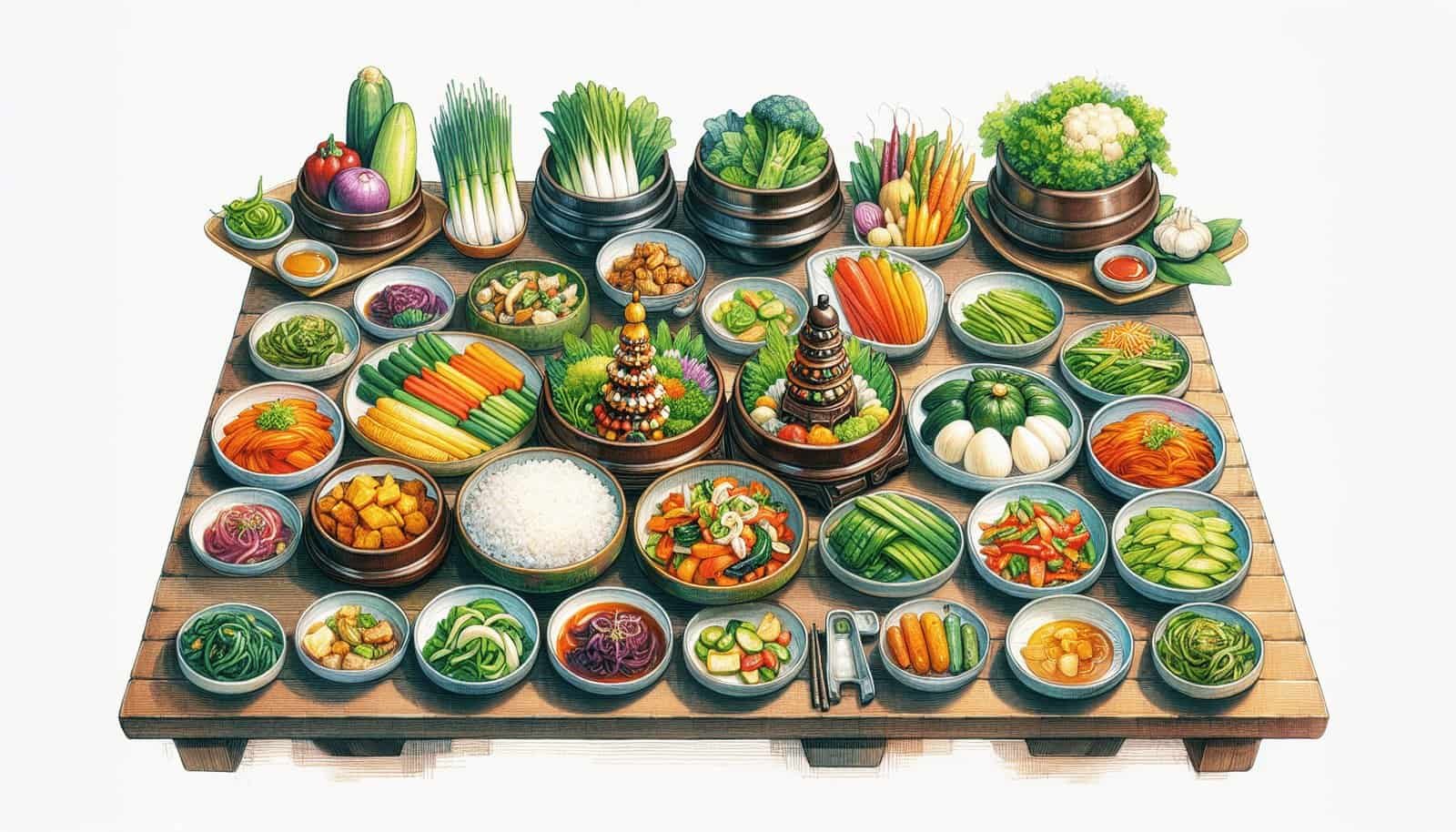Have you ever wondered what makes Korean temple cuisine distinctively unique? While South Korean culture is known for its vibrant K-Pop music, bustling cities, and technological innovations, its temple cuisine offers a tranquil and spiritually nourishing journey for food enthusiasts and seekers of healthful living alike. Rooted in centuries-old Buddhist practices, this type of cuisine emphasizes harmony with nature, balance, and mindful eating. In this article, we’ll explore various fascinating aspects of Korean temple cuisine that make it a holistic and unique culinary tradition.

Historical Background of Korean Temple Cuisine
Korean temple cuisine originated in Buddhist temples, where vegetarian practices were influenced by the monastic lifestyle. The cuisine developed over centuries as monks and nuns focused on harmonious living and enlightenment through mindful eating.
Influence of Buddhism
Buddhism preaches non-violence and compassion towards all living beings. This cardinal principle is reflected in Korean temple cuisine, which is entirely vegetarian. The belief system not only abstains from meat but also emphasizes the importance of purity and respect for nature.
Adaptation to Local Ingredients
Temples located in different geographical areas adapted their cuisine using locally available ingredients. Whether it’s the mountainous region providing wild greens and mushrooms or coastal temples offering varieties of seaweed, the local environment played a crucial role in shaping the dishes.
Core Ingredients in Korean Temple Cuisine
The foundation of Korean temple cuisine lies in simple, natural ingredients. These ingredients are not only nutritious but also reflect the monks’ deep connection to nature.
Grains and Beans
Rice and barley are the most common grains used, supported by a variety of beans like soybeans, mung beans, and adzuki beans. These provide a rich source of protein and are versatile enough to be used in multiple dishes.
Vegetables
A wide variety of seasonal vegetables form the backbone of temple cuisine. These include leafy greens, root vegetables, and wild herbs, each contributing unique flavors and nutritional benefits.
Fermented Foods
Fermentation is a key aspect of Korean cuisine and a practice deeply ingrained in temple dining. Staples like kimchi, doenjang (fermented soybean paste), and ganjang (soy sauce) not only add flavor but also serve probiotic benefits.
Natural Seasonings
Natural seasonings such as Doenjang (fermented soybean paste), Gochujang (fermented chili paste), and Ganjang (soy sauce) are integral. They are prepared with care, usually homemade within the temple walls.
Unique Preparatory Methods
The method of preparing food in Korean temple cuisine is unique and meticulous, aimed at preserving the nutritional value and flavor.
Water-Based Cooking
Rather than frying or grilling, food is often boiled or steamed. This method keeps the dishes light and easy on the digestive system, ideal for maintaining the monks’ meditative focus.
Low Oil Usage
Minimal oil is used, and when it is, sesame oil is preferred for its rich taste and nutritional value. This practice aligns with the health-conscious and minimalist lifestyle of the temple community.
Handcrafted Ingredients
Many ingredients, like tofu, kimchi, and fermented sauces, are handmade within the temple. The manual preparation is not only a practice of mindfulness but also ensures the purity and quality of the food.
Philosophical Aspects
Korean temple cuisine is deeply rooted in Buddhist philosophy, embodying principles that go beyond just the act of eating.
Mindful Eating
Each meal is a meditative experience. The focus is on eating slowly, savoring each bite, and expressing gratitude for the food. This mindfulness brings harmony between the mind, body, and spirit.
Respect for Nature
The cuisine promotes sustainable living by using seasonal and local ingredients, often grown within the temple grounds. This practice reduces the carbon footprint and fosters a deeper connection with nature.
Balance and Harmony
Ingredients are carefully chosen to balance the flavors and nutritional content. Meals are prepared to provide wholesome nourishment, balancing yin and yang through a variety of textures, flavors, and colors.

Notable Dishes in Korean Temple Cuisine
Here are some signature dishes that you’ll frequently encounter in Korean temple cuisine. Each of these dishes offers insights into the rich culinary traditions upheld by Buddhist monks and nuns.
Temple Kimchi
Unlike its spicier counterpart found commonly in Korean households, temple kimchi is generally milder. It uses less garlic and chili, aligning with the monks’ dietary restrictions. Seasonal vegetables are often fermented with natural salt and the simple seasoning of ginger.
Lotus Root Salad (Yeongeun Jorim)
Lotus roots are prized for their crunchy texture and health benefits. They are typically simmered in a light soy sauce and sweeteners like rice syrup or honey, achieving a perfect balance of sweet and savory.
Fermented Soybean Stew (Dwenjang Jjigae)
This hearty stew is made with a rich broth of fermented soybean paste, offering deep umami flavors. Vegetables such as zucchini, radish, and tofu are added to create a comforting, wholesome dish.
Wild Mushroom Stir-Fry (Beoseot Bokkeum)
Featuring a variety of wild and cultivated mushrooms, this dish is lightly stir-fried to enhance its natural flavors. Ingredients like soy sauce, sesame oil, and scallions add depth without overwhelming the palate.
Rice Wraps (Ssambap)
Rice wrapped in various leaves like lettuce, sesame leaves, or cabbage, combined with an assortment of fillings like mushrooms, tofu, and seasoned vegetables, make Ssambap a nutritious and visually pleasing dish.
Nutritional Benefits
Korean temple cuisine is not only spiritually uplifting but also remarkably nutritious, offering numerous health benefits.
Rich in Plant-Based Protein
The use of beans, tofu, and diverse grains ensures a rich intake of plant-based protein, essential for muscle repair and overall health.
High Fiber Content
Vegetables, whole grains, and legumes provide ample dietary fiber, aiding in digestion and promoting a healthy gut.
Antioxidant-Rich
Many ingredients like leafy greens, berries, and certain types of mushrooms are packed with antioxidants, helping to combat oxidative stress and chronic diseases.
Probiotic Potential
Fermented foods like kimchi and doenjang are excellent sources of probiotics, crucial for gut health and overall well-being.

How to Experience Korean Temple Cuisine
You don’t necessarily have to travel to South Korea to enjoy temple cuisine, although it can be a transformative experience. Here’s how you can immerse yourself in this unique culinary tradition from wherever you are.
Temple Stay Programs
Many temples in South Korea offer “Temple Stay” programs, where you can stay for a few days and participate in various monastic activities, including the preparation and consumption of temple food.
Cooking Classes
Several institutes and temples offer cooking classes that teach you how to prepare traditional temple dishes. This hands-on experience can be both educational and spiritually enriching.
Recipes and Home Cooking
Thanks to the proliferation of online resources, you can try simple temple cuisine recipes at home. Ingredients like doenjang, gochujang, and diverse vegetables are increasingly available at local Asian markets or online stores.
Restaurants and Cafes
With the rising popularity of health-conscious eating, some restaurants and cafes specialize in temple cuisine outside South Korea. These dining spaces aim to replicate the serene temple atmosphere and traditional dining experience.
Modern Interpretations and Variations
Fusion with Modern Cuisine
While maintaining traditional values, Korean temple cuisine has also seen contemporary interpretations by chefs. These dishes integrate ancient techniques with modern culinary trends, resulting in unique flavors and presentations.
Health and Wellness Movement
The growing global interest in vegetarian and vegan lifestyles has placed Korean temple cuisine in the spotlight. Its wholesome, organic, and balanced meals align perfectly with the modern wellness movement.
Global Adaptations
Globally, various cuisines are incorporating elements of Korean temple cuisine. Whether it’s using Korean fermented goods in Western salads or introducing mindful eating practices in different cultures, the influence of this unique culinary tradition is expanding.
Table: Comparison of Traditional and Modern Temple Cuisine Elements
| Aspect | Traditional Temple Cuisine | Modern Adaptations |
|---|---|---|
| Ingredients | Locally sourced, seasonal vegetables | Global ingredients with fusion recipes |
| Cooking Methods | Boiling, steaming, minimal oil | Incorporating modern culinary tools |
| Presentation | Simple, communal bowls | Artistic plating, individual servings |
| Flavor Profile | Mild, focused on natural flavors | Enhanced with global spices, flavors |

Sustainability and Environmental Concerns
One of the hidden gems of Korean temple cuisine is its commitment to sustainability and environmental consciousness.
Organic Farming
Many temples grow their own vegetables, herbs, and grains through organic farming practices. This method not only ensures fresh and nutritious produce but also fosters a deeper connection to the land.
Waste Minimization
From using every part of vegetables to composting food scraps, temples excel in minimizing waste. This practice aligns with the Buddhist principle of respect for all resources and mindful consumption.
Environmental Impact
By focusing on plant-based ingredients, Korean temple cuisine significantly reduces the carbon footprint associated with meat production. It demonstrates an eco-friendly approach, promoting sustainability and environmental stewardship.
Cultural Significance and Symbolism
The significance of Korean temple cuisine extends beyond physical nourishment, touching upon deep cultural and symbolic layers.
Rituals and Traditions
Meals are often preceded by rituals, such as the offering of food to the Buddha. Such practices imbue the act of eating with reverence and mindfulness, creating a sacred atmosphere around the dining experience.
Celebrations and Festivals
Certain dishes are intricately linked to Buddhist festivals and celebrations. For instance, during Buddha’s birthday, temples prepare unique dishes that not only celebrate the occasion but also embody spiritual teachings and communal harmony.
Symbolic Ingredients
Every ingredient used in temple cuisine holds symbolic meaning. For instance, lotus roots represent purity and enlightenment, while certain herbs are believed to purify the body and soul.
Societal and Personal Benefits
Engaging with Korean temple cuisine offers numerous benefits on both societal and personal levels.
Community Building
Eating together in a communal setting fosters a sense of unity and shared experience. This practice strengthens social bonds and creates a supportive community environment.
Emotional Well-being
The principles of mindful eating and minimalism reduce stress and induce a sense of calm and well-being. The simple yet flavorful dishes bring joy and satisfaction, contributing positively to mental health.
Personal Growth
The practice of preparing and consuming temple cuisine can be a meditative journey, promoting personal growth and spiritual enlightenment. It encourages you to connect deeper with yourself and your surroundings.
Conclusion
So, what makes Korean temple cuisine uniquely captivating? Its roots in Buddhist philosophy, emphasis on mindful eating, and dedication to sustainability and environmental consciousness impart a holistic approach to food that goes beyond mere sustenance. Whether you are a seasoned foodie or someone seeking a healthier, more mindful way to nourish yourself, Korean temple cuisine offers an abundance of wisdom and culinary delight. From the tranquil settings of temple stays to the modern interpretations found in global kitchens, this unique culinary tradition continues to inspire and nurture people around the world. Embrace the journey, and you might find that every meal becomes an act of meditation, a moment of profound connection with the essence of life itself.
